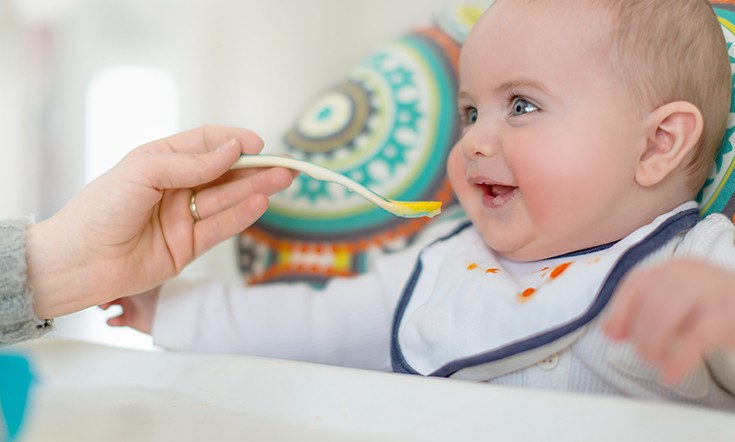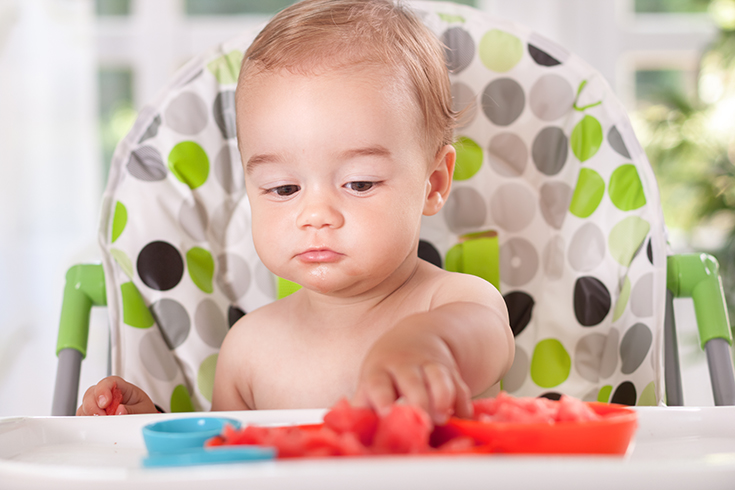

There’s a lot of conflicting information out there with regarding to introducing solids to your baby, much of it influenced by personal opinions and philosophies.
Which can make things tricky for first time mums who just want to do what’s right for their baby.
And there’s a lot to consider – when to start, how to start and what to start with.
According to Dietitian Erika Harmen, current evidence and expert opinion suggests introducing complementary solids between the ages of 4 and 6 months.
“There is little evidence that delaying the introduction of solids beyond six months of age will reduce the risk of allergies,” says Ms Harmen.
Similarly, there is no evidence to suggest delaying or avoiding potentially allergenic foods such as nuts or egg will reduce the risk of allergies or eczema.
Purees or Baby Lead Weaning?
In many parenting circles there are two camps – those that opt for purees as first foods and Baby Lead Weaning, which is when babies skip the purees and are offered age appropriate food to feed themselves.
In reatlity though, there is no one size fits all approach and many parents end up doing a combination of both approaches.
According to Ms Harmen, the best advice is to recognise that all babies progress through the so called stages of baby food textures at different rates.
Smooth and runny puree is often considered the first stage followed by mashed, then onto minced/chopped texture and finally a soft diet.
At approximately one year of age (with a few exceptions such as steak and fish with bones), a toddler should be able to join in and enjoy smaller quantities of whatever the rest of the family is eating.
“It is beneficial to move a baby through the stages at the rate they are showing they can tolerate,” says Ms Harmen.
For example, if a baby is breastfed exclusively until 6 months and is able to move straight onto and tolerate finely minced foods or soft finger foods, such as slices of ripe banana, then offer that texture.
Other babies may prefer smooth runny textured foods as their first foods.
Be guided by baby
Your baby will guide you but there are some signs that demonstrate your baby is ready to be introduced to solids.
- Good, strong head and neck control
- Ability to maintain an upright position
- Safe swallow, gag reflex
- Ability to engage with the parent/carer – eyes able to fix and follow
- Showing interest in food and people eating
It is important to remember that breast milk or formula needs to be offered first, followed by solids in small quantities, with no pressure for baby to finish what’s on offer.
That’s because when babies are learning to eat they are unable to transition fully from breast/formula to eating a full diet in the amounts they require immediately.
“So breast milk or formula remains as the backstop to provide most of the important nutrients as the baby learns to eat and is able to include more and more food groups in their diet until they are safely eating foods from all food groups in the recommended amounts,” says Ms Harmen.
At around nine months of age, food can be offered first, followed by milk.
Introducing new foods
The best way to introduce new foods is one at a time and in small amounts every two or three days, says Ms Harmen.
Introduce one new food at a time so reactions to it can be more clearly identified.
Once it is established that the food is tolerated, keep that food in their diet and introduce another new food in the same way.
It is also important to keep a baby moving through the texture stages.

“For example, a 1 year old child should be eating most of what the family eats (except steak or fish with bones) and not still be on a smooth pureed diet unless it is medically indicated,” says Ms Harmen.
Once it is established a baby is coping well with a texture, trial the next stage.
New foods/textures should ideally be offered when baby is well rested, happy and well.
“Trialing new foods or textures when a baby is sick or tired will not be a pleasant experience for baby or parent and may in fact set baby back if it is an experience that ends in choking or vomiting.”
It’s also important that baby is ready – be guided by cues.
If a baby refuses a new food, try it again another time.
How much food does baby need?
Be guided by their appetite. Stop feeding when the baby is demonstrating she’s has had enough, for example clamping lips shut or turning her head away.
As long as baby is growing well – along centile lines and has plenty of wet nappies, regular bowel motions – he is getting enough food, says Ms Harmen.
Remember at age 4 – 9 months offer milk first followed by food. At age 9 months food can be offered first.
Food allergies
A food allergy occurs when there is an abnormal reaction by the immune system to a component in food, usually a protein.
The immune system responds by generating antibodies which can trigger symptoms such as hives, swelling around the mouth, vomiting or diarrhea, difficulty breathing, collapsing or anaphylaxis (severe allergic reaction).
A food intolerance is different from food allergies, says Ms Harmen as it does not involve the immune system.
“It occurs when you have an enzyme deficiency such as lactose or when you have reactions to natural or artificial substances in food.”
Symptoms can include headaches, skin rashes, stomach upsets.
Variety is key
Variety is extremely important, though it can be tricky with some fussy eaters.
Ms Harmen suggests that once a range of vegetables/fruit and protein sources have been trialed for tolerance, keep rotating them to expose your baby to as many different flavours and tastes to encourage variety in the diet.
First food ideas
- Soft steamed vegetables
- Sliced/Soft fruit such as banana, pawpaw, nectarine, Raisins/dried apricots
- Sliced/grated cheese
- Soft sandwiches with crusts cut off
- Home made Fish fingers/ Chicken nuggets
- Mini meatballs
- Soft crackers
- Cooked pasta shapes Boiled peas
- Spaghetti/baked beans
- Yoghurt
- Lamb cutlets
- Hard boiled eggs
- Any meat/chicken/fish dish can be pureed.
Most vegetables and fruits can be pureed – avoid stringy types e.g. green beans and celery. Avocado/Egg/Fish/baked beans can be mashed to a smooth lump-free consistency easily























